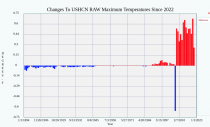Jan 25, 2025
The 2024 Hurricane Season
Paul Homewood
London, 28 January: The Global Warming Policy Foundation (GWPF) has today published its periodic review of global hurricane activity. The review is based on the findings of key scientific bodies, comparing them to sensationalist news reporting and popular perceptions.
Trends in landfalling Atlantic/western Pacific hurricanes have been stable or decreasing since 1950.
There is also no global trend in overall hurricane frequency since reliable records began in the 1970s.
The apparent increase in the number of hurricanes since the 19th century has been due to changes in observation practices over the years, rather than an actual increase.
Data show no long-term trends in US landfalling hurricanes since the mid-19th century, when systematic records began, either in terms of frequency or intensity.
Similarly, after allowing for the fact that many storms were not spotted prior to the satellite era, there are no such trends in Atlantic hurricanes either.
There is growing evidence that wind speeds of the most powerful hurricanes may now be overestimated in comparison to pre-satellite era ones, because of changing methods of measurement.
The increase in Atlantic hurricanes in the last fifty years is not part of a long-term trend, but is linked to a recovery from a deep minimum in hurricane activity in the 1970s, associated with the Atlantic Multidecadal Oscillation.
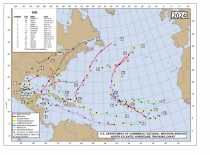
The author, climate researcher Paul Homewood, said:
“The observational findings of meteorological agencies in 2024 once again confound those who claim to see a ‘climate crisis’ in the hurricane data. It is clear that we have not seen an increase in hurricane frequency, even though the public have been scared into thinking that tropical storms are getting worse.”
GWPF Director, Dr Benny Peiser, said:
“The gap between media hype, popular perceptions and the reality of empirical data is becoming ever more evident. This report sets out the facts and is a welcome corrective to misleading news coverage of hurricanes.”
Read the full paper here: The 2024 Hurricane Season (pdf)
Jan 20, 2025
Weather Rant by Professor Art Horn, Meteorologist AMS
Weather Rant by Professor Art Horn, Meteorologist AMS
"The opinions that are held with passion are always those for which no good ground exists; indeed the passion is the measure of the holders lack of rational conviction.” - Bertrand Russell 10/10/21
Published at theartofweather.net
Wednesday June 7th, 2023
There’s just too much going on not to talk about it. To quote Jack Klompus from Seinfeld “I’m sorry. I’m sitting here, the whole meeting, holding my tongue. I’ve known you a long time Morty, but I cannot hold it in any longer.”
I’m referring to the current situation of the Canadian wildfires and the resulting and persistent smoke issues down here in the United States. Under normal conditions a large very slow-moving storm rotating counterclockwise in the Canadian Maritimes would be circulating cool, dry, clean Canadian air into the New England. There is such a storm present in that location now. But with all these fires in Quebec Province the storm that is situated in the Maritimes is doing the opposite! The smoke from the fires is whirling around the storm and blowing into portions of New England.
Of course, predicably the media outlets are blaming climate change for the fires. But wildfires have always been part of nature’s balance between too much forest and too little. The “culling of the herd”, in this case old or weak trees, has historically been in part accomplished with what are called wildfires.
One of the most spectacular examples of this phenomena occurred on May 19th, 1780 during the revolutionary war. General George Washington noted in his diary that on that day darkness enveloped the sky. It was so dark during the morning that candles were lit to see their way about. People left their jobs and school children were sent home. Some prayed while others cried or went to taverns. Washington noted that the darkness varied and that the sun came out in the afternoon perhaps indicating that it was entirely hidden by the smoke in the morning.
Research indicates that the fires that caused the darkness were in the Algonquin Highlands of Ontario Canada. The meteorological conditions that brought the dense cloud of smoke to the region in 1780 is unknown but likely similar to what is happening now.
Today there are wildfires around the world every day just as there have been for millions of years. But today we have a new culprit of combustion that is not related to the doings of nature. I’m speaking of eco-terrorists. Nobody in the media seems to want to even suggest the idea that at least some of the current wildfires are the result of eco-terrorists. It’s not a far-fetched idea based on what’s been gong on around the world these days.
For instance, there’s the group “Just stop Oil” that’s made news with their adolescent, attention grabbing stunts of despoiling priceless works of art around the world. The group known as “Extinction Rebellion” and their antics such as holding protests in roadways to block traffic to call attention to their believe that climate change is going to end the world as we know it.
Another ultra-fringe climate change gang of bizarre individuals that calls themselves “Tyre Extinguishers” has claimed responsibility for deflating 100 sport utility vehicles in Copenhagen yesterday. They claim they are “defending themselves from climate change, air pollution and unsafe drivers. Gee, I guess climate change is so bad now that it causes unsafe drivers! They claim to have destroyed tires of people that own SUV’s in multiple countries. People have tried to reason with them but the negotiations fell flat!
The people that populate these extremist groups are, in my opinion hopeless malcontents. If it wasn’t climate change that they are fighting to stop, they would find some other cause to bring about their delusional mayhem.
Then we have the case of Audrey Elaine Dunham of Glendon Alberta. In court on February 15th, 2022 she was convicted on four counts of mischief against property in connection with multiple arson fires in the Bonnyville area of Alberta Canada. She actually admitted to setting 32 fires at the hearing! Apparently she was quite proud of her destruction. She was sentenced to 9 months in jail but amazingly she served no jail time.
Can I prove that at least some of these current fires have been deliberately set by eco-terrorists? No, not until someone claims responsibility or is arrested but it seems plausible to me.
Why would someone want to destroy forests that they claim they are trying to save? At least part of the answer is that by starting the fires and then blaming the cause on climate change they get the news coverage they couldn’t get any other way. The news media actually does the work for them since they are obsessed with climate change causing everything! Today every natural disaster they report about is now the result of climate change.
As a side note I saw yet another of the seemingly endless stories about sea ice loss in the Arctic. This story from the thedailybeast.com reports that another computer model study forecasts that after the year 2030 there will be no sea ice in the Arctic Ocean by the end of the summer.
Of course, one has to only go back to 2007 when there were similar predictions warning that by 2022 summer sea ice would be long gone from the Arctic. Another in the long line of climate change forecasts fails. Actually, sea ice data from the Danish Meteorological Institute reveals that as of today the amount of Arctic sea ice is within 75 percent of the 1981 to 2010 average for this time of year. Where are you going to see that in the news? Nowhere!
Dec 28, 2024
‘Trump effect’ undermines U.N. climate summit: COP29’s failure is great news for humanity
By Marc Morano
The 2024 U.N. Climate Change Conference in Baku, Azerbaijan, recently wrapped up. The summit can be summed up in one phrase: The orange man derailed it.
The election of former President Donald Trump a few days before the Conference of the Parties, known as COP29, began had a profound impact on zapping any potential success from the summit. The Times of London wrote that the “wind was taken out of [COP29’s] sails before it even started with the election of climate-skeptic Donald Trump in the U.S.”
The disillusionment of COP29’s attendees was palpable. No major Western leaders bothered to show up in Baku except the U.K.[s newly minted prime minister, Keir Starmer.
‘Total waste of time’
The supposedly sinking Pacific island nations could not even muster up enthusiasm for COP29 as the nation of Papua New Guinea boycotted the confab, declaring it a “total waste of time.”
France boycotted attending COP29. Politico reported, {The French climate minister’s withdrawal means Paris will not send any high-level political representative to Baku, as French President Emmanuel Macron will also skip the event.” Oui oui!
Oil is a ‘gift of God’
It gets better. In what can be described only as the “Trump effect,” Argentina withdrew its negotiators from the summit after President Javier Milei held talks with Mr. Trump; Argentina’s entire team was ordered home.
“We have instructions from the Ministry of Foreign Affairs to no longer participate,” Argentina’s top environmental official told The Guardian.
There’s more.
The opening day of the U.N. climate summit featured Ilham Aliyev, Azerbaijan’s president, declaring oil a “gift of God” and said people need oil. As you can imagine, Mr. Aliyev’s invoking God to defend the use of oil enraged and demoralized the attendees of COP29.
The BBC reported on the oily mess, noting in a headline: “UN climate talks ‘no longer fit for purpose’ say key experts.”
U.N. officials turn on - the U.N.
The COP process needs “an urgent overhaul,” according to an open letter by the former U.N. secretary-general, the former U.N. climate chief and other U.N. supporters, the BBC reported. The erstwhile U.N. officials demanded that {countries should not host the talks if they don’t support the phase-out of fossil energy.”
Former Vice President Al Gore agreed, saying: “I think that there should be a test for who is qualified to be a delegate to these COPs. Are they coming to try to find a solution or are they coming in order to block a solution?”
In other words, censor and ban any nation from the U.N. climate process that dissents in any way from the U.N. agenda. They appear to want to run the U.N. climate summits like a “woke” social media platform.
‘Worst U.N. climate summit’ ever!
COP29 was initially billed as the COP finance summit. The original $100 billion-a-year climate slush fund was pledged to increase to $300 billion a year. But no one seemed happy about these “pledges.”
The Times of London reported on the utter failure of the summit. “Cop29 was described by veteran negotiators as the worst UN climate summit they had experienced.”
And here[s one more scoop from CNN: “COP29 was described by climate activists as ‘an insult, a joke and a betrayal… A conference of chaos.”
A fake dead whale
One final bizarre note: COP29 featured a dead fake whale made of what appeared to be petroleum-based products on display in downtown Baku. The fake whale carcass had a backdrop of COP29’s neon messaging on a building, complete with a windmill. Just to be clear, the climate activists who sponsored this fake dead whale stunt believed that climate change is a threat to whales - and windmills will somehow save the whales.
No irony is lost in the fact that since the rapid ascent of offshore wind, deaths of actual whales have skyrocketed.
As with every U.N. climate summit, many studies are timed to be released in the weeks and days before the conference to maximize the alleged importance of the U.N.’s mission. This year’s round of studies was quite humorous. A study in the journal Lancet claimed that “Climate change is causing sleep loss.”
Not to be outdone, a study published in the peer-reviewed journal Environment, Development and Sustainability actually claimed that ‘climate change is encouraging unsanitary toilet practices among vulnerable communities.” How? “"Climate change makes toilets more likely to break, which leaves people more likely to ‘go’ outside.’”
Remember: Don’t ever question “the science”!
Meat tax for thee
The conference featured prominent speeches calling for meat rationing and a global “meat tax” to limit “cow emissions.” Willem Branten of the group True Animal Protein Price Coalition called for meat taxes :so that we can pay for the damages done by our past consumption of meat and animal proteins.”
The U.N. was full of meat hypocrisy as delegates chowed down on beef, chicken and hot dogs at the restaurants and food courts of COP29.
As Mr. Trump prepares to return to the White House, we must remember: The failure of a U.N. climate summit is great news for humanity!
* Marc Morano manages the award-winning ClimateDepot.com news and information service. He served as a reporter for Rush Limbaugh’s television show and as a senior adviser to Sen. James Inhofe.
Dec 27, 2024
Hunga Tonga volcano: impact on record warming
By Javier Vinos
The climate event of 2023 was truly exceptional, but the prevailing catastrophism about climate change hinders its proper scientific analysis. I present arguments that support the view that we are facing an extraordinary and extremely rare natural event in climate history.
1. Off-scale warming
Since the planet has been warming for 200 years, and our global records are even more recent, every few years a new warmest year in history is recorded. Despite all the publicity given each time it happens, it would really be news if it didn’t happen, as it did between 1998 and 2014, a period popularly known as the pause.
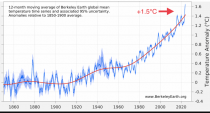
Figure 1. Berkeley Earth temperature anomaly
Since 1980, 13 years have broken the temperature record. So, what is so special about the 2023 record and the expected 2024 record? For starters, 2023 broke the record by the largest margin in records, 0.17C. This may not sound like much, but if all records were by this margin, we would go from +1.5C to +2C in just 10 years, and reach +3C 20 years later.
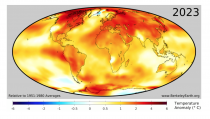
Figure 2. Berkeley Earth 2023 temperature anomaly
Moreover, to produce so much warming, almost the entire globe experienced above-average warming. 2023 was a year of real global warming, although most of the warming occurred in the Northern Hemisphere.
As a result, one of the major databases, Berkeley Earth, has exceeded the +1.5C limit for a full year for the first time, and 2024 promises another temperature record. Crossing the dangerous warming threshold so early has caused some confusion, exacerbated by the fact that not much difference seems to be noticeable. Even Arctic ice remains above the average of the last decade. And if we’ve already crossed the line and the climate is beyond repair, what’s the point of trying?

Figure 3. Global temperature calculation by Copernicus system.
But the authorities have been quick to point out that even if we are above +1.5C in 2023 or 2024, we will not have crossed the threshold. There is a catch. The global temperature is not the temperature of one month or one year, but the temperature of the linear trend of the last 30 years, which according to the European Copernicus system is +1.28C and is expected to exceed +1.5C in 10 years. Link
2. Uncharted territory
In June 2023, the North Atlantic experienced a heat wave unprecedented in 40 years, with temperatures 5C warmer than usual. Carlo Buontempo, the director of Copernicus, said the world was “entering uncharted territory. We have never seen anything like this in our life”. To understand what has puzzled scientists so much, it is necessary to look at the evolution of the temperature of the Earth’s oceans throughout the year since 1979.
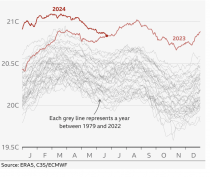
Figure 4. 60N-60S global ocean surface temperature by year since 1979.
On average, the Earth’s oceans are warmest in February-March and coldest in October-November, with an intermediate maximum in August. This is an annual cycle caused by the tilt of the Earth’s axis, the arrangement of the continents, and seasonal changes in atmospheric circulation and albedo. A cycle that has never been broken as long as measurements have been kept until 2023. This year shows an accentuated warming since January, leading to daily temperature records since the beginning of April. But what is absolutely astonishing is that the ocean continued to warm in June and July and reached an annual maximum in August, something that has never happened before. And the warming through August is staggering, about 0.33C above the 2016 record, which is huge for the ocean. After that, the annual cycle begins to behave normally, but at a much higher temperature, which is slowly falling. In June 2024, after 415 days of record temperatures, the ocean is still about 0.2C warmer than it should be.
Buontempo means good weather in English, and his phrase “we have entered uncharted territory” has become very popular. However, it assumes that we have reached and will remain in this situation, whereas the data suggest that this is a one-off anomaly with diminishing effects. For now, it tells us that nothing dramatic is happening as we approach the politically established warming threshold.
Gavin Schmidt, director of NASA’s climate monitoring institute, also uses the expression “uncharted territory” when he explains that the 2023 anomaly worries scientists, saying that climate models cannot explain why the planet’s temperature suddenly spiked in 2023. Not only was the temperature anomaly much larger than expected, but it occurred months before the onset of El Nino. In his own words: “The 2023 temperature anomaly has come out of the blue, revealing an unprecedented knowledge gap perhaps for the first time since about 40 years ago. It could imply that a warming planet is already fundamentally altering how the climate system operates, much sooner than scientists had anticipated.:[iii] According to Gavin, we could have broken the climate and the models would no longer work.
Instead of abandoning science for wild speculation let’s examine the possible factors responsible for the abrupt warming that Gavin Schmidt dismisses by saying they could explain at most a few hundredths of a degree, for which he has little evidence.
3. The little boy is innocent
El Nino is unlikely to be responsible for the simple reason that such abrupt global warming is unprecedented in our records, and El Nino has many precedents. In addition, El Nino warms a specific region of the equatorial Pacific and primarily affects the Pacific, while the :2023 event” warmed parts of the North Atlantic to an extraordinary degree. This does not prevent scientists like Jan Esper and Ulf Buntgen from saying that 2023 is consistent with a greenhouse gas-induced warming trend amplified by an El Nino.[iv] They clearly did not examine the data before writing this, nor did the reviewers of their Nature paper.
The relationship between the temperature of the equatorial Pacific and that of the global ocean during an El Nino is shown in the figure below.
Figure 5. Nino 3.4 temperature anomaly (red) and detrended satellite global ocean temperature anomaly (black).
The temperature anomaly in the Pacific Nino 3.4 region shows the very strong Ninos of 1983, 1998, and 2016, and the strong Ninos of 1988, 1992, 2009, and 2024. The years correspond to the month of January during the event. When the satellite global ocean temperature anomaly is plotted without its long-term trend, we observe a very close correspondence. The long-term trend responds to other causes, but the temperature variations correspond to the export of heat from the equatorial Pacific to the rest of the globe.
We also observe two things. The first is that the correspondence fails in two periods, in 1992 as a result of the Pinatubo eruption a year earlier, and in 2024. The second observation is that in all strong or very strong Ninos, the source of the heat, the equatorial Pacific, warms earlier and warms more or as much in relative terms as the global ocean warms later. This does not happen in the 2024 El Nino. The warming is simultaneous and greater than it should be outside the equatorial Pacific.
The Pacific Decadal Oscillation (PDO) is often described as a long-lived pattern of climate variability similar to El Nino in the North Pacific. And this is evident when we compare the two after removing a long-term trend that the PDO should not have. The agreement is very strong, and again we see a significant anomaly in 1991 due to the Pinatubo eruption. But even more important is the anomaly in 2023-24, when the PDO shows extraordinarily small changes and remains negative when it should be positive.
Figure 8. During the 2023 event the North Pacific stayed in negative PDO conditions, while the equatorial Pacific displayed El Nino conditions.
To understand this response, one must consider that the warm phase of the PDO requires the Northwest Pacific to be cold, but as we have shown above, the Northwest Pacific was very warm in 2023, causing the PDO to remain in a cold phase. A negative phase of the PDO during El Nino is unprecedented and categorically rules out El Nino as the cause of the abrupt warming that has puzzled scientists. In fact, it is possible that the ocean warming that began in March 2023 was the cause of the 2024 El Nino by weakening the trade winds in the equatorial Pacific.
I’d like to thank Charles May for bringing this data to my attention and for doing such an excellent job analyzing it each month.
4. Sulfate aerosols are not responsible
Another possibility that is under consideration is the reduction of sulfate aerosols as a result of the change in marine fuel regulations in 2020.
Figure 9. Global sulfur emissions for the past 64 years
The reduction in sulfur emissions since the late 1970s is considered a significant warming factor by reducing emissions of shortwave radiation reflected from the atmosphere. However, the reduction in sulfur dioxide emissions from marine fuels since 2020 is estimated at 14% of total emissions.
Figure 10. Model-calculated global temperature effect of an 80% reduction (red curve) in marine fuel sulfur content from pre-2020 situation (blue curve), and decadal mean difference (green bars).
A recent study, still under peer review, used a climate model to calculate that sulfur emission reductions from 2020 could cause global warming of 0.02C in the first decade.[v] Since the warming in 2023 was 10 times greater, it is difficult to believe that emissions reductions since 2020 could have been a major factor in the abrupt warming in 2023.
In the figure, the blue curve is the global warming predicted with the previously used marine fuel, and the red curve is the one predicted with the fuel with 80% less sulfur. The difference between the two curves for the decade 2020-30 is the green bar of 0.02C.
5. CO₂ increase didn’t do it
The amount of CO₂ in the atmosphere has increased slightly by about 2.5 parts per million in 2023.
Figure 11. Monthly (red) and 12-month (black) CO₂ levels at Mauna Loa.
The increase from 418.5 to 421 ppm represents an increase of 0.6% and is similar to the increase that has occurred each year for the past several decades. Nothing in our knowledge of the effect of CO₂ increases on climate suggests that such a small increase could have led to such a large and abrupt warming. There is no study to suggest that the gradual increase in CO₂ could lead to a sudden increase in climate variability. Therefore, all model predictions are long-term and affect the statistics of weather phenomena. The proof is that scientists and models cannot explain what happened in 2023.
6. Tonga volcano prime suspect
Just over a year before the abrupt warming, in January 2022, an extremely unusual volcanic eruption took place in Tonga. How unusual? It was an eruption of VEI 5 explosivity, capable of reaching the stratosphere, which occurs on average every 10 years.
Figure 12. Time and cone elevation of VEI ≥5 volcanic eruptions of the past 200 years, their distribution by altitude (yellow bars), and the suggested depth for a submarine eruption capable of projecting a large amount of water to the stratosphere (red line).
There have been a number of eruptions with VEI 5 or higher in the last 200 years, although not all of them have affected the global climate. This figure shows with dots the date they occurred and the elevation at which the volcanic cone was located. The yellow bars show the distribution of eruptions in 500 m elevation bins. The Tonga eruption was a submarine explosion at very shallow depths, about 150 m below the sea surface. It ejected 150 million tons of water into the stratosphere.
In our 200 years of records there is only one other submarine eruption with VEI 5, which occurred in 1924 off the Japanese island of Iriomote at a depth of 200 m and did not affect the atmosphere. Only surface effects were observed. NASA scientists believe that the Tonga explosion occurred at the right depth to project a lot of water into the stratosphere.[vi] This depth is indicated by the red line. So, the Tonga eruption is a once in 200-year event, probably less than once in a millennium. Science was very lucky. We are not so lucky.
We know that strong volcanic eruptions, capable of reaching the stratosphere, can have a very strong effect on the climate for a few years, and that this effect can be delayed by more than a year. The eruption of Mount Tambora in April 1815 had a global effect on the climate, but it took 15 months for the effect to develop, during the year without a summer of 1816. These delayed effects coincided with the appearance of a veil of sulfate aerosols in the Northern Hemisphere atmosphere due to seasonal changes in the global stratospheric circulation.
Figure 13. Stratospheric water vapor anomaly at 45 N.
In this image on the vertical axis, we observe the water vapor anomaly in the stratosphere between 15 and 40 km altitude with ocher tones for negative values and greenish for positive ones. The measurement takes place at 45 latitude in the northern hemisphere. On the horizontal axis is the date, and we can see that the large anomaly created by the Tonga eruption does not appear in the Northern Hemisphere until one year later, in 2023, when the warming occurred. Thus, there are dynamical events in the stratosphere that have the appropriate time lag to coincide with the abrupt warming in 2023.
Because the Tonga eruption is unprecedented, there is much about its effects that we do not understand. But we do know that the planetary greenhouse effect is very sensitive to changes in stratospheric water vapor because, unlike the troposphere, the stratosphere is very dry and far from greenhouse saturation.
As a group of scientists showed in 2010, the effect of changes in stratospheric water vapor is so important that the warming between 2000 and 2009 was reduced by 25% because it decreased by 10%.[vii] And after the Tonga eruption, it increased by 10% because of the 150 million tons of water released into the stratosphere, so we could have experienced much of the warming of an entire decade in a single year.
Figure 14. Global water vapor anomaly above 68hPa.
The stratosphere has already begun to dry out again, but it is a slow process that will take many years. In 2023 only 20 million tons of water returned to the troposphere, 13%.[viii]
7. Dismissing natural warming
On the one hand, we have an absolutely unprecedented abrupt warming that the models cannot explain and that has scientists scratching their heads. Such anomalous warming cannot logically respond to the usual suspects, El Nino, reduced sulfur emissions, or increased CO₂, which have been going on for many decades.
On the other hand, we have an absolutely unprecedented volcanic eruption, the effects of which we cannot know, but which, according to what we know about the greenhouse effect, should cause significant and abrupt warming.
Of course, we cannot conclude that the warming was caused by the volcano, but it is clear that it is by far the most likely suspect, and any other candidate should have to demonstrate its ability to act abruptly with such magnitude before being seriously considered.
So why do scientists like Gavin Schmidt argue, without evidence or knowledge, that the Tonga volcano could not have been responsible? If the effect were cooling, the volcano would be blamed without a second’s hesitation, but significant natural warming undermines the message that warming is the fault of our emissions.
This article can also be watched in a 19-minute video with English and French subtitles.
Copernicus Global temperature trend monitor.
[ii] CNN July 8, 2023. Global heat in ‘uncharted territory’ as scientists warn 2023 could be the hottest year on record.
[iii] Schmidt, G., 2024. Why 2023’s Heat Anomaly Is Worrying Scientists. Nature, 627.
[iv] Esper, J. et al., 2024. 2023 summer warmth unparalleled over the past 2,000 years. Nature, pp.1-2.
[v] Yoshioka, M., et al., 2024. Warming effects of reduced sulfur emissions from shipping. EGUsphere, 2024, pp.1-19.
[vi] Lee, J., & Wang, A., 2022. Tonga eruption blasted unprecedented amount of water into stratosphere. NASA Jet Propulsion Lab.
[vii] Solomon, S., et al., 2010. Contributions of stratospheric water vapor to decadal changes in the rate of global warming. Science, 327 (5970), pp.1219-1223.
[viii] Zhou, X., et al. 2024. Antarctic vortex dehydration in 2023 as a substantial removal pathway for Hunga Tonga‐Hunga Ha’apai water vapor. Geophysical Research Letters, 51 (8), p. e2023GL107630.
[ix] Guterres, A., 2024. Secretary-General’s special address on climate action “A Moment of Truth”.




